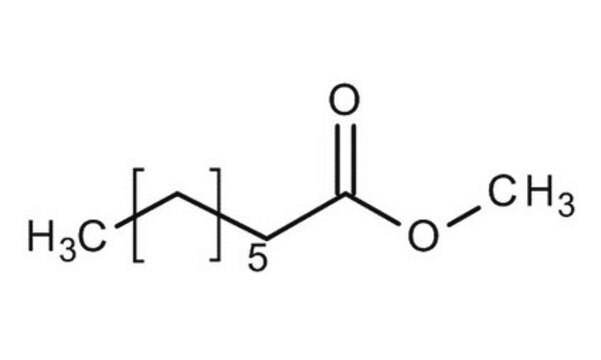299030
Methyl decanoate
99%
Sinônimo(s):
Capric acid methyl ester, Decanoic acid methyl ester, Methyl caprate
About This Item
Produtos recomendados
Nível de qualidade
Ensaio
99%
Formulário
liquid
índice de refração
n20/D 1.425 (lit.)
p.e.
108 °C/10 mmHg
224 °C (lit.)
pf
−14-−11 °C (lit.)
solubilidade
chloroform: soluble 100 mg/mL, clear
densidade
0.871 g/mL at 20 °C (lit.)
grupo funcional
ester
cadeia de caracteres SMILES
CCCCCCCCCC(=O)OC
InChI
1S/C11H22O2/c1-3-4-5-6-7-8-9-10-11(12)13-2/h3-10H2,1-2H3
chave InChI
YRHYCMZPEVDGFQ-UHFFFAOYSA-N
Procurando produtos similares? Visita Guia de comparação de produtos
Categorias relacionadas
Descrição geral
Aplicação
- Application of mist to fingermark detection: Misting with high-boiling-point liquid containing p-dimethylaminocinnamaldehyde and cyanoacrylate.: This article explored the use of high-boiling-point liquids, including methyl decanoate, in misting techniques for forensic fingermark detection. (Takatsu et al., 2023).
Palavra indicadora
Warning
Frases de perigo
Declarações de precaução
Classificações de perigo
Aquatic Acute 1 - Aquatic Chronic 2
Código de classe de armazenamento
10 - Combustible liquids
Classe de risco de água (WGK)
WGK 1
Ponto de fulgor (°F)
230.9 °F - Pensky-Martens closed cup
Ponto de fulgor (°C)
110.5 °C - Pensky-Martens closed cup
Equipamento de proteção individual
Eyeshields, Gloves, type ABEK (EN14387) respirator filter
Escolha uma das versões mais recentes:
Certificados de análise (COA)
Não está vendo a versão correta?
Se precisar de uma versão específica, você pode procurar um certificado específico pelo número do lote ou da remessa.
Já possui este produto?
Encontre a documentação dos produtos que você adquiriu recentemente na biblioteca de documentos.
Os clientes também visualizaram
Nossa equipe de cientistas tem experiência em todas as áreas de pesquisa, incluindo Life Sciences, ciência de materiais, síntese química, cromatografia, química analítica e muitas outras.
Entre em contato com a assistência técnica









